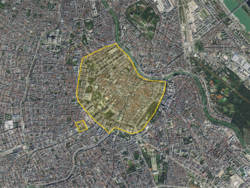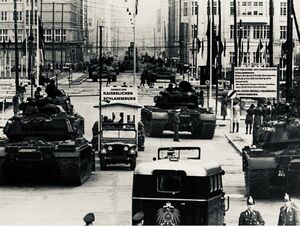Imperial Schlammburg
Imperial Schlammburg
Imperial Territory within Schlammburg | |
|---|---|
Imperial City | |
 The borders of Imperial Schlammburg as defined in the 1862 Capital Decree, superimposed on a sattelite image of Schlammburg. | |
| Country | Dolchland |
| Constituent State | Imperial Territory |
| Capital Decree | 1865 |
| Founded by | Wilhelm I |
| Area | |
| • Total | 3.09 km2 (1.19 sq mi) |
| Population | |
| • Total | 11,320 |
| • Density | 3,700/km2 (9,500/sq mi) |
The Imperial Territory within Schlammburg, commonly called Imperial Schlammburg, is the capital territory of the Empire of Dolchland. It is the only territory directly under the control of the Imperial Government. The territory is located in the centre of the city of Schlammburg, the capital of the Dolchic state, Panedonia. It houses most of the Imperial Government ministries, along with the official residence and court of the Emperor. Imperial Schlammburg was established in 1865 by Emperor Wilhelm I, King of Panedonia, as a place to house the various government ministries and foreign embassies. Since the individual kingdoms could not decide on a neutral territory to hold such institutions, a 3.9 square kilometre area of central Schlammburg was carved out and declared independent of Panedonia. The Imperial Territory is the only place in the Empire where the Imperial military has full jurisdiction, maintaining a barracks in the city since 1879.
1959 Crisis
In 1959 Emperor Friedrich II was in the 14th year of his rule. Friedrich, along with being Emperor, was the King of Habstria and thus being of the House of Ausburg, the historic rival of Panedonia and the House of Falkenburg, which controlled surrounding Schlammburg. In 1959 Friedrich made an attempt to bring greater imperial control over the individual states' militaries, in an attempt to federalise the Empire. This caused great controversy among the other Kings of Dolchland, who had developed their own highly capable militaries, many on par with the Imperial forces. After a stand-off between the Emperor and King of Panedonia in a summit in Enselhof Palace, the Panedonian King ordered his tanks to roll up to the border of Imperial Schlammburg, which had been somewhat militarised since the House of Ausburg retook the Imperial throne in 1901.
The Emperor called the Panedonian's bluff by sending his own imperial army tanks, stationed in the barracks, to face the Panedonian tanks head on. The tanks remained there for 43 days, with the only movement between the Imperial territory and Schlammburg being food supply trucks, which were allowed after 16 days of cutting off the Imperial territory. On the 39th day, the Emperor called the Panedonian King in hopes of easing the situation, which had spread to other parts of the Empire, with the Habstrian-Macklenovarian border being remilitarised, along with that of Bessen-Katzenelm and Wurveria. The King initially responded aggressively, secretly hoping that this could lead to an overthrow of the Ausburg dynasty's rule of Dolchland. However, after consulting several other Dolchic monarchs, he agreed that at noon on the 43rd day of the stand-off he would withdraw his troops. On the 42nd day however, a Habstrian general, Hans von Ludenburg, stole a horse from the Imperial stables, and charged at the Panedonian defences, possibly hoping to kill the crown prince of Panedonia, who was visiting the troops at the border. Immediately after he crossed the border, he was shot by defending Panedonians, and died within a few minutes. The two commanders at either end of the border agreed that this shouldn't affect the agreement, and von Ludenburg was declared rogue by the Imperial Army, as to prevent further escalation. At 12:00 PM on the 43rd day of the crisis, the tanks began pulling back from the border, and within a few hours residents were passing through the border as they were before.
The crisis represents the closest any of the Kingdoms of Dolchland has come to coming into conflict with one another since the 19th century, and ultimately lead to the modernisation of the Dolchic state.
